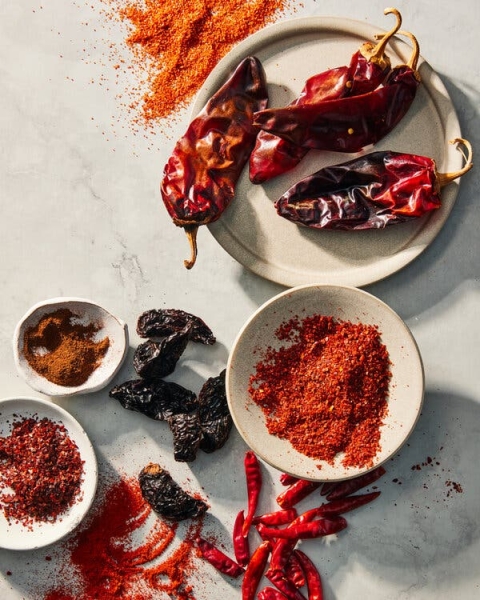There are so many kinds of red-pepper flakes. Getting to know them all can give your dishes a glow up.
Eric Kim keeps at least 17 different dried chile products — whole, flaked and powdered — in his pantry and freezer at all times.
Raised in an Armenian household in Santa Clara, Calif., Levon Minassian recalls trips to the Middle Eastern spice shop where his parents bought Aleppo pepper, the mild, fruity red-chile flakes named after the Syrian city, to use in all manner of dishes at home. Culled from big bins and decanted into bags dragged home, the crimson powder was sprinkled over labneh, baba ghanouj and soups, each pinch a burst of sunlight.
Now, as a founder of Fire Tongue Farms, about 30 miles south in Santa Cruz, Mr. Minassian, 34, grows fresh Aleppo peppers and many other chile varieties, dries them and processes them into flakes. At the moment, his Aleppos are green, but soon they will be red, sun-dried and milled, fragrant with the sweetness of time.
Like Aleppos (also known as Halaby peppers), many of the world’s most delicious dried red-chile powders and flakes belong to the Capsicum annuum species, a plant with many varietals and what the chef and food historian Maricel Presilla calls, in her book “Peppers of the Americas,” “both the greatest world traveler of all peppers and the one found in the most incredibly diverse forms.” These include jalapeños, cayenne and bell peppers.
You know what else is part of this pepper group? Gochugaru, the sweet, fragrant Korean chile flakes that dye kimchi red; togarashi, a bright-orange powdered chile from Japan; fruity, moderately spiced Espelette pepper, named for a French commune and prevalent in Basque cooking; ground chipotle, jalapeños that have been dried and smoked; paprika, which comes in many styles but especially sweet, hot and smoked; and more.
By viewing chiles not just by heat level but by flavor, we the curious — home cooks who like to linger in the kitchen — can wander a world of culinary possibilities. So my question to you is: What’s in your pepper pantry?
There’s nothing wrong with the shaker of pizza shop red-pepper flakes — the one next to the oregano and Parmesan — but it’s just one color in a spectrum of chile possibilities. The joy of cooking with dried chiles is mixing and matching. Why paint in gray when you can access a full palette of brilliant colors?
Thank you for your patience while we verify access.
